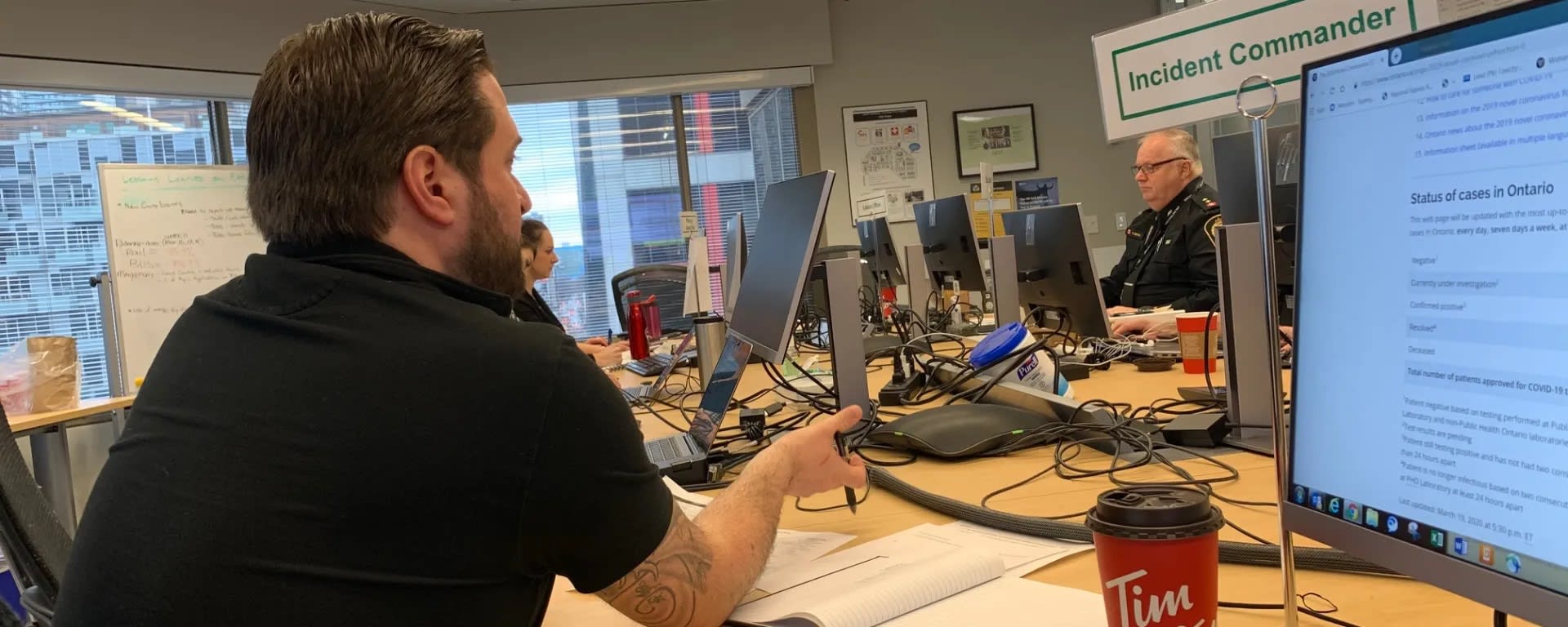The heart of Metrolinx’s COVID-19 response - the command center
Metrolinx media relations head takes us through the agency’s Emergency Operations Centre.
Mar 23, 2020
For Metrolinx, it’s our nerve-centre in responding to the greatest health challenge in a generation.
A command post that, minute by minute, is keeping tabs on GO Transit and UP Express – as well as PRESTO – during the COVID-19 crisis.
And as Metrolinx’s senior manager for media and emergency information officer for COVID-19 and responsible to oversee all communications (both internal and external) to ensure consistency and accuracy, this is where I – and others – work. So I thought you might appreciate seeing inside our Emergency Operations Centre (EOC).
My day starts by first taking my temperature—a habit learned from days at Toronto Public Health. On the way to work I take a couple of media calls while on an empty TTC bus. Before I head to the EOC, I stop at Union Station to check in on some of our staff—the heroes on the frontlines. Then grab my coffee nearby and head through security to get into the centre, which is already buzzing with activity.
Metrolinx has had an experienced Incident Command Team (ICT) in place since January – developing and implementing a COVID-19 strategy to ensure our organization was well prepared for the potential of a pandemic in our community.
The team has gathered for meetings regularly – often virtually. But now the pandemic is here and the province has declared a state of emergency.
It’s a new day and new ways of responding – quickly.
Staff work inside the emergency operations centre – a life-line of COVID-19 information for customers and communities. (Anne Marie Aikins photo)
Metrolinx recently opened its EOC – located in downtown Toronto – to coordinate our essential services, anticipate needs and respond to issues in real time. The site also supports executive decision-making and ensures we liaise with our emergency management, transit, public health and government partners.
In some ways, it looks much like any large office area, with computers and a bit of a make-shift sign on the door. Phones ring constantly, virtual meetings held often and information traded rapidly across every digital tool available.
“Our focus remains crystal clear,” said Jeff Harris, the COVID-19 incident commander and responsible for the overall management of the response, who reports to Martin Gallagher, Metrolinx’s chief safety officer. “Every action we implement must ensure the health and safety of our staff and our customers, that continues to be our first priority.”
The ICT is represented by all critical functions and supported by teams on the ground, including operations, such as bus, rail and stations, emergency information for customers, staff, contractors and stakeholders, human resources and procurement, to ensure we have the appropriate supports in place.
The skilled managers on ICT ensure our executive management team, led by Metrolinx CEO Phil Verster, is kept informed and updated on a fast-moving situation – one that reaches far beyond our transit routes.
Together, the team has decades of experience helping Metrolinx and other public services manage through emergencies. A few most recent include SARS (2003), H1N1 (2009), G20 (2010) and the massive ice storm and flooding (2013).
Though, yes, with all the combined years of leadership, these are extraordinary times as we react to events, never before seen in our lifetime.
But the response is steady by veteran members.
Inspector Steve Harvey, a 30-year transit safety officer, is emergency management liaison and is focused on coordinating the Metrolinx response with all of our partners.
“The EOC ensures Metrolinx is providing a lifeline to the people that need to get to work at our hospitals, shelters and other essential services throughout the region,” Harvey said.
“In real time, but ensuring we are protecting our own health, we work together to provide strategic direction, gather resources, problem-solve and be ready for whatever this emergency may bring.”
Metrolinx has both a pandemic plan and business continuity plan to ensure we continue operating our vital services through the course of the pandemic.
Ridership is dramatically down as residents listen to health officials to try to hunker down. But there are still a great many people, including hospital workers and first responders, who count on our transit to get them to where they need to go.
“The situation is very fluid,” Harris added, “and we have been adjusting our strategy and response as the circumstances change.”
That’s included returning some early morning trains, so downtown Toronto hospital workers can get to early shifts on time. You can find that story here.
Previous experience and training in emergency management has made it abundantly clear — during a crisis, the public requires information in real time to ensure they have the most accurate and up-to-date facts and news from reliable sources.
It is our commitment at Metrolinx to ensure we communicate transparently, promptly and compassionately with all of our customers and staff. That’s a big part of my role as the emergency information officer.
That’s why I’m taking a moment to explain, a bit, how our emergency operations centre works.
It is our goal to be a reliable source of information. This includes media and social media, on the phone, website and in person.
Someday we will be talking about the COVID-19 emergency with our children and grandchildren. What we all – including you – did to get through the pandemic of 2020.
by Anne Marie Aikins Chief spokesperson
